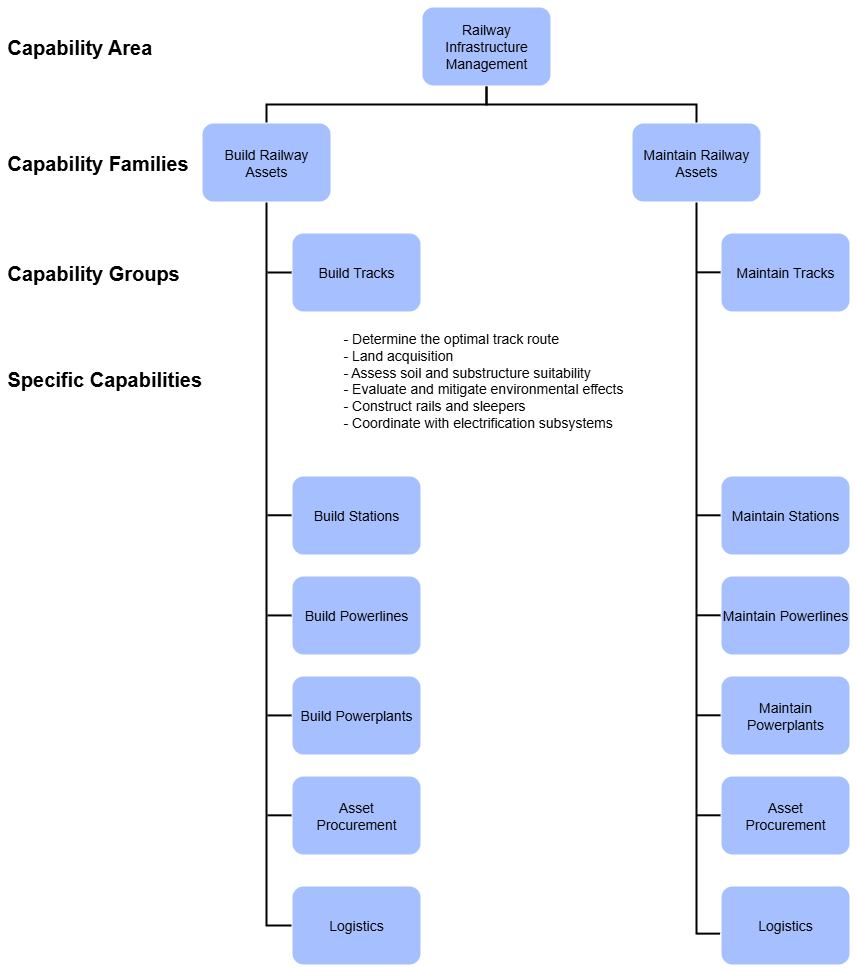No edit summary |
No edit summary |
||
| (2 intermediate revisions by the same user not shown) | |||
| Line 1: | Line 1: | ||
<small>[[Capability Modeling Guidelines|Capability Modelling Guidelines]] | [[Capability_Modeling_Guidelines:_How_to_Structure_a_Capability_Map|How to Structure a Capability Map]]</small> | <small>[[Capability Modeling Guidelines|Capability Modelling Guidelines]] | [[Capability_Modeling_Guidelines:_How_to_Structure_a_Capability_Map|How to Structure a Capability Map]]</small> | ||
=Capability | =Capability hierarchy= | ||
A [[capability]] hierarchy is a tree (whole/part relationship) of the [[enterprise|enterprise's]] [[capabilities]], from broad, high-level [[capabilities]] at the top (Level 1) to increasingly detailed, granular sub-[[capabilities]] at lower levels (Level 2, Level 3, and so on). Superordinate [[capabilities]] represent a whole and subordinates represent its parts. By tracing between the higher, more strategic level to specific [[capabilities]] hierarchies encourage iteration while supporting coarse to granular assessment of performance. This is essential in making strategy actionable. | A [[capability]] hierarchy is a tree (whole/part relationship) of the [[enterprise|enterprise's]] [[capabilities]], from broad, high-level [[capabilities]] at the top (Level 1) to increasingly detailed, granular sub-[[capabilities]] at lower levels (Level 2, Level 3, and so on). Superordinate [[capabilities]] represent a whole and subordinates represent its parts. By tracing between the higher, more strategic level to specific [[capabilities]] hierarchies encourage iteration while supporting coarse to granular assessment of performance. This is essential in making strategy actionable. | ||
| Line 11: | Line 11: | ||
The highest level represents the major business areas of the [[enterprise]]. May not be needed for small [[enterprises]]. | The highest level represents the major business areas of the [[enterprise]]. May not be needed for small [[enterprises]]. | ||
''Example: | ''Example: 'Railway Infrastructure Management' '' | ||
'''Capability Family:''' | '''Capability Family:''' | ||
| Line 17: | Line 17: | ||
Breaks down [[capability]] areas into more specific families of [[capabilities]]. | Breaks down [[capability]] areas into more specific families of [[capabilities]]. | ||
''Example: | ''Example: 'Build Railway Assets' '' | ||
'''Capability Group:''' | '''Capability Group:''' | ||
| Line 23: | Line 23: | ||
Makes [[capability]] families more concrete | Makes [[capability]] families more concrete | ||
''Example: | ''Example: 'Build Tracks' '' | ||
'''Specific Capabilities:''' | '''Specific Capabilities:''' | ||
| Line 29: | Line 29: | ||
Further elaborates on [[capability]] groups into very specific [[capabilities]]. Here an [[enterprise]] assesses performance, makes sourcing decisions, and addresses gaps. | Further elaborates on [[capability]] groups into very specific [[capabilities]]. Here an [[enterprise]] assesses performance, makes sourcing decisions, and addresses gaps. | ||
''Example: | ''Example: 'Assess soil and substructure suitability' '' | ||
<br><br> | <br><br> | ||
[[File: CMG_Hierarchy_1.png]] | [[File: CMG_Hierarchy_1.png]] | ||
==Practical | ==Practical tips== | ||
'''The number of levels depends on the size of your organisation''' | '''The number of levels depends on the size of your organisation''' | ||
Large [[enterprises]] typically have | Large [[enterprises]] typically have 'business areas', which means that four levels are often apropriate. Most smaller [[enterprises]] can be modelled with the other three levels only. | ||
'''Focus on specific [[capabilities]] (level 4) when designing potential future-state options''' | '''Focus on specific [[capabilities]] (level 4) when designing potential future-state options''' | ||
While levels 1-3 are more for the [[enterprise]]-wide, strategic view, specific [[capabilities]] are needed to discuss and design the future state in concrete design challenges (see: [[Capability_Modeling_Guidelines:_Indicate_Where_to_Focus|Indicate where to focus]]). | While levels 1-3 are more for the [[enterprise]]-wide, strategic view, specific [[capabilities]] are needed to discuss and design the future state in concrete design challenges (see: [[Capability_Modeling_Guidelines:_Indicate_Where_to_Focus|Indicate where to focus]]). | ||
<br><br> | |||
{| style="width:100%;" | |||
| style="text-align:left; width:50%;" |[[Capability_Modeling_Guidelines:_Capability_Categories|← Previous page]] | |||
| style="text-align:right; width:50%;" | [[Capability_Modeling_Guidelines:_Designing_around_Activities_or_Objects|Next page →]] | |||
|} | |||
Latest revision as of 13:46, 13 September 2025
Capability Modelling Guidelines | How to Structure a Capability Map
Capability hierarchy
A capability hierarchy is a tree (whole/part relationship) of the enterprise's capabilities, from broad, high-level capabilities at the top (Level 1) to increasingly detailed, granular sub-capabilities at lower levels (Level 2, Level 3, and so on). Superordinate capabilities represent a whole and subordinates represent its parts. By tracing between the higher, more strategic level to specific capabilities hierarchies encourage iteration while supporting coarse to granular assessment of performance. This is essential in making strategy actionable.
EDGY suggests the following levels:
Capability Area:
The highest level represents the major business areas of the enterprise. May not be needed for small enterprises.
Example: 'Railway Infrastructure Management'
Capability Family:
Breaks down capability areas into more specific families of capabilities.
Example: 'Build Railway Assets'
Capability Group:
Makes capability families more concrete
Example: 'Build Tracks'
Specific Capabilities:
Further elaborates on capability groups into very specific capabilities. Here an enterprise assesses performance, makes sourcing decisions, and addresses gaps.
Example: 'Assess soil and substructure suitability'

Practical tips
The number of levels depends on the size of your organisation
Large enterprises typically have 'business areas', which means that four levels are often apropriate. Most smaller enterprises can be modelled with the other three levels only.
Focus on specific capabilities (level 4) when designing potential future-state options
While levels 1-3 are more for the enterprise-wide, strategic view, specific capabilities are needed to discuss and design the future state in concrete design challenges (see: Indicate where to focus).
| ← Previous page | Next page → |